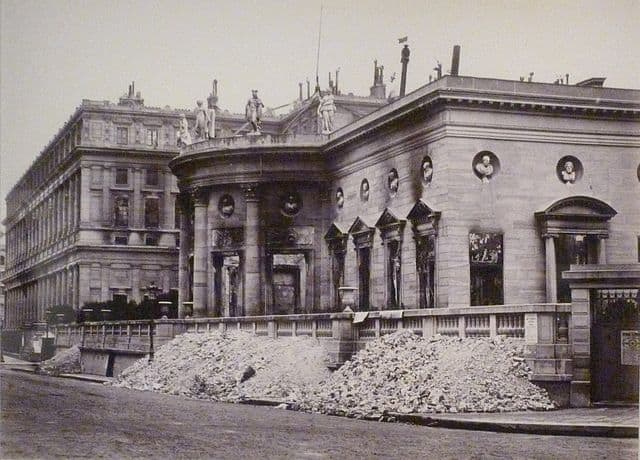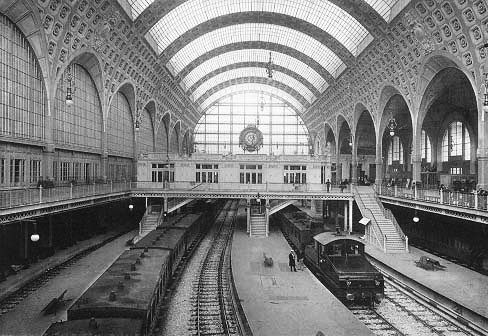History of the Musée d’Orsay: Before the Art
Paris is such an old city, that it should come as no surprise that many of the monuments and museums served different purposes before they became the places to learn and explore that we know today.
The Musée d’Orsay is no exception! Located on the banks of the Seine in the 7th arrondissement, across the river from the Louvre, the museum is the best place in Paris to check out some amazing Impressionist art.
This museum happens to be one of my favourites (I even tend to prefer it to the Louvre!), as I love artists like Claude Monet and Vincent Van Gogh.
Are you curious to learn more about the history of the museum, before the art? Keep reading!
Practical Information:
Entry fee: 14 euros
Opening hours: Tuesday-Sunday 9:30am-6pm, Thursday until 9:45pm. Closed Monday.
Address: 1 Rue de la Légion d’Honneur, 75007 Paris
Metro station: Gare Musée d’Orsay / Solférino
Early years of the Musée d’Orsay
Before the French court moved to Versailles in 1682, the king, queen and the rest of the nobility lived in the Louvre Palace. As I’ve already mentioned, the Orsay is located just across the Seine River from the Louvre. This meant that the royal grounds once extended over to the rue de Lille, the street that runs along the backside of the museum.
The street was originally the main path of the royal garden that king Henri IV built for his queen, Marguerite de Valois. After her death in 1615, the grounds were sold and mansions began popping up along the Seine.
Around the same time, a port called the Grenouillière was being used to store lumber and other various materials. In 1708, construction of the Quai d’Orsay began at the Port Royal, and was completed nearly 100 years later.
At the end of the 18th century, the Hôtel de Salm, which was then renamed the Palais de la Légion d’honneur, was constructed. Soon after, in the early 19th century, two buildings were built on the site of the future Musée d’Orsay: the Calvary barracks and the Palais d’Orsay. The buildings were built between 1810 and 1838.

The Palais de la Légion d’honneur as occupied by the Paris Commune. Image originally provided by the Musée Carnavalet – WikiCommons
In 1871, during the bloody civil war known as the Paris Commune, the entire area was burnt down by revolutionaries. The site remained abandoned for nearly 30 years before the Orsay train station was built!
The Musée d’Orsay as a train station
In 1897, the Compagnie Paris-Orléans purchased the burned lot in order to construct a modern train station. The project would be difficult, as Paris urged the company to build a station that would blend in with the architecture of the area. The company eventually chose the architect Victor Laloux to design the station in 1898.
The Gare d’Orsay (sometimes called the Gare d’Orléans) was completed in only 2 years, just in time to be showcased at the 1900 World’s Fair. Laloux decided to mask the appearance of the station with a façade that resembled a hotel built in the Beaux-Arts style! It was the perfect fit amongst the Louvre and the Palais de la Légion d’honneur next door. The station was really modern for it’s time, and featured ramps and elevators for passengers and their luggage, 16 underground tracks, electric rails and a service desk to help welcome visitors. There was also a grand hall which was 32 metres high and 40 metres long! This was the elegant train station that Paris had been waiting for.
For nearly 40 years, between 1900 and 1939, the Gare d’Orsay served as the main station that brought trains to and from the southwestern corner of France to Paris. But, by 1939, the station would begin servicing only the Parisian suburbs. The platforms had become too short for the new, modern, electric trains that were being built at the time.
Then, World War II happened. The station was used as a mailing center for sending packages to prisoners of war. After the end of the war, the station was used as a location for shooting movies, as a reception hall, and Charles de Gaulle even held a press conference there when he announced he was returning to his role as president.
The Musée d’Orsay today
In 1973, the station was officially closed. Then, in 1975, the Direction des Musées de France came looking for a new place for a museum. The city of Paris had a lot of art from the second half of the 19th century that was just begging for a home.
The site originally faced threats of being replaced by a massive hotel, but in 1978, the ancient train station was named a historic monument. Abandoned train station plus art needing a home equals the bright idea of the Musée d’Orsay!
A committee was soon put together in order to organize the plans for the new museum. Then on 1986, the president at the time, François Mitterrand officially inaugurated the Musée d’Orsay.
The committee wanted to preserve the incredible 19th century Beaux-Arts architecture inside the station, and they did a wonderful job. If you look closely at the walls in the museum, you can still see the names of the train stations that the Gare d’Orsay serviced when it was operating!
Today, you can see the works of Monet, Van Gogh, Rodin, and Cézanne, to name a few of the artists who’s works are housed at the Orsay. It is also the 6th most visited monument in Paris!
Notable works
Here is a brief list of some must-see works (and a few of my personal favorites) inside the Musée d’Orsay:
- Small Dancer, aged 14 by Edgar Degas
- Luncheon on the Grass by Eduard Manet
- Starry Night Over the Rhone by Vincent Van Gogh
- Bal du Moulin de la Galette by Pierre-Auguste Renoir
- The Cardplayers by Paul Cézanne
- London, Houses of Parliament by Claude Monet
- Porte de l’Enfer by Auguste Rodin
- L’Age mûr by Camille Claudel
Conclusion
I hope you’ve learned a lot about one of my favorite museums in Paris, the Musée d’Orsay! Have you visited yet? Do you want to now? I hope so!
Paris is absolutely teeming with history. Now you know a little bit more about the history of the Musée d’Orsay…before the art!
If you want to tour the Musée d’Orsay when you’re in Paris, we’ve got you covered. Click here to read more about our skip-the-line Orsay & Montmartre tour, and click here for all of our walking tour options!
Planning a trip to Paris ? Get ready !
These are Amazon’s best-selling travel products that you may need for coming to Paris.
Bookstore
- The best travel book : Rick Steves – Paris 2023 – Learn more here
- Fodor’s Paris 2024 – Learn more here
Travel Gear
- Venture Pal Lightweight Backpack – Learn more here
- Samsonite Winfield 2 28″ Luggage – Learn more here
- Swig Savvy’s Stainless Steel Insulated Water Bottle – Learn more here
Check Amazon’s best-seller list for the most popular travel accessories. We sometimes read this list just to find out what new travel products people are buying.















